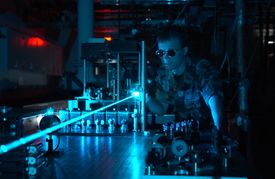عملية كهروضوكيميائية
العملية الكهرضوكيميائية Photoelectrochemical process هي العملية التي تتضمن تحويل الضوء إلى شكل من أشكال الطاقة الكهربائية أو الكيميائية.[1] تطبق هذه العمليات في مجال الكيمياء الضوئية و مجال مضخات الليزر البصرية و الخلايا الشمسية النوعية ومجالات الضيائية إضافة إلى التأثيرات على التغيرات اللونية عند التعرض للضوء.
. . . . . . . . . . . . . . . . . . . . . . . . . . . . . . . . . . . . . . . . . . . . . . . . . . . . . . . . . . . . . . . . . . . . . . . . . . . . . . . . . . . . . . . . . . . . . . . . . . . . . . . . . . . . . . . . . . . . . . . . . . . . . . . . . . . . . . . . . . . . . . . . . . . . . . . . . . . . . . . . . . . . . . . .
إثارة الإلكترونات
تعرف عملية إثارة الإلكترون بأنها عملية نقل الإلكترون إلى مستوى طاقة أعلى. وتتم هذه العملية أما بواسطة الإثارة الفوتونية حيث يمتص الإلكترون المثار الفوتون ويكسب جميع طاقة الفوتونات الساقطة عليه. أو عبر الإثارة الكهربائية بحيث يمتص الإلكترون الطاقة من إلكترونات أخرى.
الإثارة الضوئية
التزامر الضوئي
في الكيمياء، التزامر الضوئي Photoisomerization
التأين الضوئي
For photons with greater energy than this, the energy of the emitted photoelectron is given by:
where h is Planck's constant and ν is the frequency of the photon.
This formula defines the photoelectric effect.
التأين متعدد الفوتونات
تأثير دمبر الضوئي
- مقالة مفصلة: دمبر الضوئي
قانون گروتوس-دريپر
قانون شتارك-أينشتاين
قانون شتارك-أينشتاين Stark–Einstein law مسمى على اسمي الفيزيائيين الألمانيين يوهانس شتارك وألبرت أينشتاين, who independently formulated the law between 1908 and 1913. It is also known as the photochemical equivalence law or photoequivalence law. In essence it says that every photon that is absorbed will cause a (primary) chemical or physical reaction.[2]
The photon is a quantum of radiation, or one unit of radiation. Therefore, this is a single unit of EM radiation that is equal to Planck's constant (h) times the frequency of light. This quantity is symbolized by γ, hν, or ħω.
The photochemical equivalence law is also restated as follows: for every mole of a substance that reacts, an equivalent mole of quanta of light are absorbed. The formula is:[2]
حيث NA هي رقم أڤوگادرو.
The photochemical equivalence law applies to the part of a light-induced reaction that is referred to as the primary process (i.e. absorption or fluorescence).[2]
الامتصاص
- مقالة مفصلة: امتصاص (اشعاع كهرومغناطيسي)
التحسس الضوئي
مطيافية الامتصاص
انظر أيضاً
- Photoelectrochemistry
- Ionization energy
- Isomerization
- Photoionization mode
- Photochromism
- Photoelectric effect
- Photoionization detector
المراجع
- ^ Gerischer, Heinz (1985). "Semiconductor electrodes and their interaction with light". In Schiavello, Mario (ed.). Photoelectrochemistry, Photocatalysis and Photoreactors Fundamentals and Developments. Springer. p. 39. ISBN 9789027719461.
- ^ أ ب ت "Photochemical equivalence law". Encyclopædia Britannica Online. Retrieved 2009-11-07.
